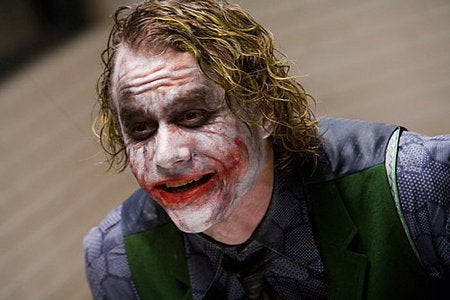
I am facially disfigured. The left side of my face and neck is empurpled and engorged by "veins gone wild" in the form of a congenital venous malformation. My appearance has been further distorted by multiple surgeries and radiation therapy.
And I am tired of seeing people like me portrayed as evil in the movies.
In the movie The Dark Knight, I watched Aaron Eckhart being transformed from a handsome and virtuous district attorney into a revenge-bound monster. How? Through the magic of facial disfigurement!
I understand that movies are a visual medium, but what message does that deliver to a veteran with the side of his face blown off or burnt in combat? What does a child with a cleft lip think about herself when the Joker points to his scarred mouth to explain why he is a sociopath?
The Lion King's adversary is named Scar. We conclude immediately that he is wicked. An iconic family movie thereby teaches young children that any facial difference, however small, will similarly identify them as evil.
Every second of The Passion of the Christ was scrutinized for anti-Semitism. How could reviewers and audiences have completely overlooked the use of facially different children to portray the demons terrorizing Judas? This artistic shortcut is so trite as to be almost subliminal, so taken for granted that it is never questioned except in the hidden places of the heart where self-image is formed.
The Phantom is defined by disfigurement and forced to live, hidden and fearful, in the dark. The moment you see the Phantom's mask, you know that his love of music and the incredible gifts he has brought to the world of opera are meaningless. Scars always trump talent when artistic vision is limited. Of course, romance is dangled before him and cruelly yanked away.
The list of cinematic disfigured villains is long: Freddy Kreuger. Darth Vader. Scarface. Almost all of Dick Tracy's criminals. Quasimodo. Charlize Theron in Monster.
Yes, there are exceptions, like the saintly Elephant Man and the more fully realized Rocky Dennis in Mask. J.K.Rowling dealt creatively with Harry Potter's cute lightning "scar" in her books, including seeing it as a source of self-realization, but the movies missed or dodged that point.
Face it. There is no cinematic metaphor more hackneyed or shallow. Time after time, the facially disfigured are shown as barely human, driven insane by deformity and ready to retaliate with mutilations or murder. Their highest motivation is revenge.
Funny thing -- in my work as a performer and keynote speaker, I have met thousands of facially different people who bring astounding gifts to the world and who, in fact, radiate beauty. You know what? I've never met a single axe murderer!
There is more at stake here than Hollywood's artistic laziness and lack of imagination.
For most of my life, I was very ashamed of my appearance. Paradoxically, I have found wholeness through, and with, what first seemed to be a grotesque flaw. Working through my fear and shame, I have come to discover that I am whole. My shadow side-my difficulty, my challenge-is on the outside, where I have been forced to deal with it.
I do know what it is like to be out in the world feeling monstrous. Every time I walk out my front door, I deal with stares, comments and the occasional cruelty, even to the extent of having someone spit in my face. It is not the fact of my disfigurement that wears on my psyche. It is the fear and self-doubt of others. In fact, it is their worry about being rejected and abandoned, which they project onto me. That's one of the jobs of the visibly disabled, to carry the fears of others who then can pretend that they are normal.
I have learned that my face is a gift. Not one that I was excited about, not at first. It is a gift because I have been forced to look inside to find my self worth. And that is exactly what everyone-not just the facially disfigured person-has to do to reach spiritual and emotional maturity.
My favorite work is at middle schools, where my wife Marlena and I do a program titled Love at Second Sight, about appearance and acceptability. What else is more important to a 12 year old seeking to find a sense of self and a place in the world among his or her peers? Afterward, the children often confide in us about their self-perceived flaws and it is clear that in many cases, those perceptions have contributed to diminished self-image.
It is not only children. The first time I gave a talk about facial difference, a very lovely woman came up to me, clasped my hand and said, "David, you are so courageous. It was terrible for me in school and, as a matter of fact, I am still very embarrassed and ashamed of my freckles." I looked down, thinking to myself, "Really! The heartbreak of freckles!" And yet I could see that her anxiety and implicit self-disparagement were real.
Here is the crux of it: everyone has the fear of being in some way defective, unlovable and unacceptable to society. That is the true disfigurement. The place deep inside us where that fear lives is where predators come to feed.
I submit that there is another way of looking at facial difference-one based on the truth of human experience. The artistic metaphor of a scarred face can be one of personal integration. Every person must reach the point of self acceptance. That magical moment is the key to living an integrated and full life. A person with facial difference can represent someone who has lived through that moment.
My face is unique but my inner experiences are universal and very, very human.
So please, Hollywood, could we try for a little more imagination and creativity? An about face, perhaps? Don't make me get the chainsaw.